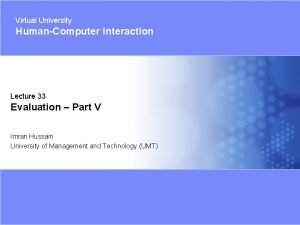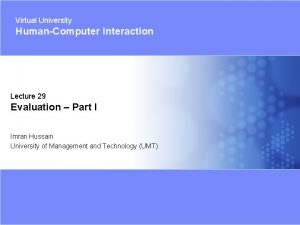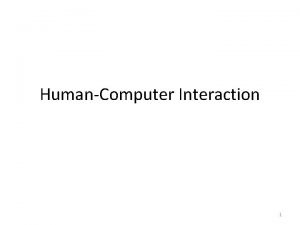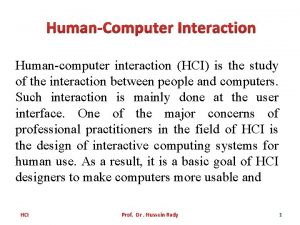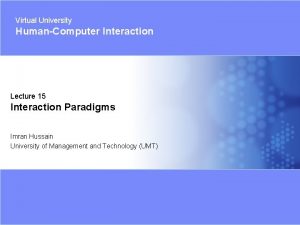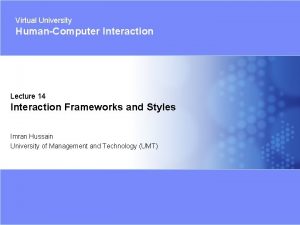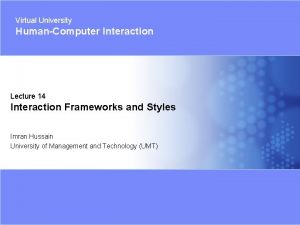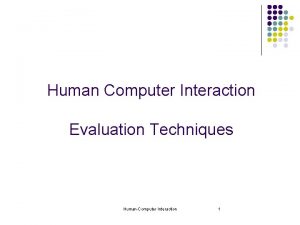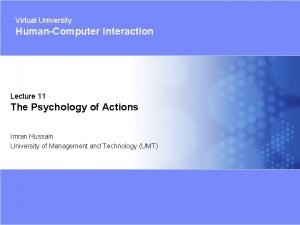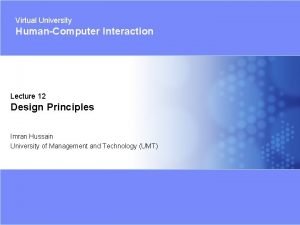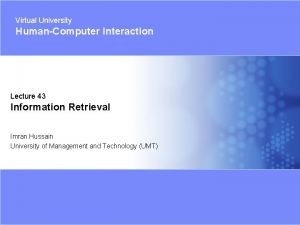Virtual University HumanComputer Interaction Lecture 30 Evaluation Part














- Slides: 14

Virtual University Human-Computer Interaction Lecture 30 Evaluation – Part II Imran Hussain University of Management and Technology (UMT) 1 Virtual University - Human Computer Interaction © Imran Hussain | UMT

In Last Lecture … • Introduction to evaluation – – 2 What Evaluation is? Significance and importance of evaluation Different paradigms Different techniques which constitute this paradigm Virtual University - Human Computer Interaction © Imran Hussain | UMT

Evaluation The process of systematically collecting data that informs us about what it is like for a particular group of users to use a product for a particular task in a certain type of environment 3 Virtual University - Human Computer Interaction © Imran Hussain | UMT

In Today’s Lecture … • Framework to guide evaluation process • Usability testing 4 Virtual University - Human Computer Interaction © Imran Hussain | UMT

Framework to guide evaluation • DECIDE framework • 6 unique phases – Determine the overall goals that the evaluation addresses. – Explore the specific questions to be answered. – Choose the evaluation paradigm and techniques to answer the questions – Identify the practical issues that must be addressed, such as selecting participants – Decide how to deal with the ethical issues. – Evaluate, interpret, and present the data. 5 Virtual University - Human Computer Interaction © Imran Hussain | UMT

Determine the goals • What are the high-level goals of the evaluation? • Who wants it and why? 6 Virtual University - Human Computer Interaction © Imran Hussain | UMT

Explore the questions • In order to make goals operational, questions must be answered to satisfy them. • For example – – 7 What are customers’ attitude to these new tickets? Do customers have adequate access to computers to make bookings? Are they concerned about security? Does this electronic system have a bad reputation? Virtual University - Human Computer Interaction © Imran Hussain | UMT

Choose the evaluation paradigm and techniques 8 Virtual University - Human Computer Interaction © Imran Hussain | UMT

Identify the practical issues that must be addressed • Users and the participants • Facilities and equipment • Schedule and budget constraints – Time and budget constraints are also important considerations to keep in mind. • Expertise – Does the evaluation team have the expertise to do the evaluation. 9 Virtual University - Human Computer Interaction © Imran Hussain | UMT

Decide how to deal with the ethical issues. 10 Virtual University - Human Computer Interaction © Imran Hussain | UMT

Evaluate, interpret, and present the data • Reliability – The reliability or consistency of a technique is how well it produces the same results on separate occasions under the same circumstances. • Validity – Validity is concerned with whether the evaluation technique measures what it is supposed to measure. • Biases – Biases occur when the results are distorted. • Ecological validity – Ecological validity is concerned how the environment in which an evaluation is conducted influence or even distorts the results. 11 Virtual University - Human Computer Interaction © Imran Hussain | UMT

Usability testing • Plan and Prepare for the test – – – – – 12 Planning the usability test Defining goals and concerns Deciding participants Recruiting participants Selecting and organizing tasks to test Deciding how the measure usability Preparing test material Preparing test environment Preparing test team Conducting a pilot test Virtual University - Human Computer Interaction © Imran Hussain | UMT

Usability testing • Defining goals and concerns and then decide who should be the participants in the usability test 13 Virtual University - Human Computer Interaction © Imran Hussain | UMT

Selecting task and creating task scenarios and preparing test materials 14 Virtual University - Human Computer Interaction © Imran Hussain | UMT
 01:640:244 lecture notes - lecture 15: plat, idah, farad
01:640:244 lecture notes - lecture 15: plat, idah, farad Has virtual functions and accessible non-virtual destructor
Has virtual functions and accessible non-virtual destructor Virtual university mba
Virtual university mba Leeds uk virtual slides
Leeds uk virtual slides Virtual university examination software
Virtual university examination software Virtual university of tunis hours
Virtual university of tunis hours National virtual university
National virtual university University of delaware virtual microscope
University of delaware virtual microscope Part whole model subtraction
Part whole model subtraction Unit ratio definition
Unit ratio definition Brainpop ratios
Brainpop ratios Technical object description example
Technical object description example What are the parts of the bar
What are the parts of the bar The phase of the moon you see depends on ______.
The phase of the moon you see depends on ______. Two way anova minitab 17
Two way anova minitab 17















